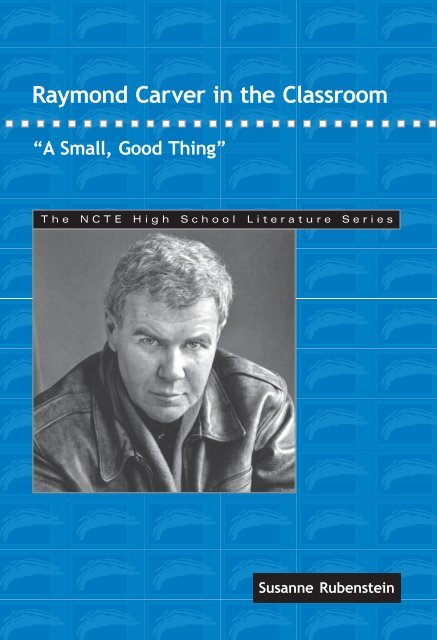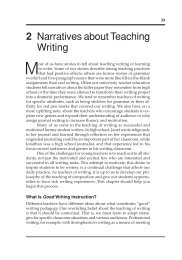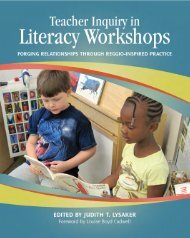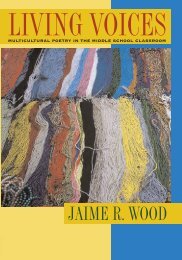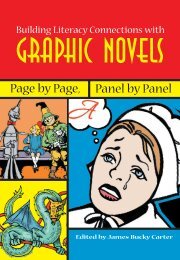Raymond Carver in the Classroom - National Council of Teachers of ...
Raymond Carver in the Classroom - National Council of Teachers of ...
Raymond Carver in the Classroom - National Council of Teachers of ...
- No tags were found...
Create successful ePaper yourself
Turn your PDF publications into a flip-book with our unique Google optimized e-Paper software.
<strong>Raymond</strong> <strong>Carver</strong> <strong>in</strong> <strong>the</strong> <strong>Classroom</strong>“A Small, Good Th<strong>in</strong>g”The NCTE High School Literature SeriesSusanne Rubenste<strong>in</strong>
■ ■ ■ ■ ■ ■ ■ ■ ■ ■ ■ ■ ■ ■ ■ ■ ■ ■ ■ ■ ■ ■ ■ ■ ■ ■ ■ ■runn<strong>in</strong>g headContents■ ■ ■ ■ ■ ■ ■ ■ ■ ■ ■ ■ ■ ■ ■ ■ ■ ■ ■ ■ ■ ■ ■ ■ ■ ■ ■ ■ ■ ■Acknowledgments . . . . . . . . . . . . . . . . . . . . . . . . . . . . . . . . . . . . . . . . . . . . . . . . . . . . . . . . . . ixIntroduction . . . . . . . . . . . . . . . . . . . . . . . . . . . . . . . . . . . . . . . . . . . . . . . . . . . . . . . . . . . . . .xi1. Where Life and Art Intersect . . . . . . . . . . . . . . . . . . . . . . . . . . . . . . . . . . . . .12. Writ<strong>in</strong>g from Models . . . . . . . . . . . . . . . . . . . . . . . . . . . . . . . . . . . . . . . . . . . . . . 17Interlude: Outside Look<strong>in</strong>g In. . . . . . . . . . . . . . . . . . . . . . . . . . . . . . . . . . . . . . . 363. Revision: A Not-So-Small, Good Th<strong>in</strong>g . . . . . . . . . . . . . . . . . . . . . . . . . 39Interlude: Sustenance. . . . . . . . . . . . . . . . . . . . . . . . . . . . . . . . . . . . . . . . . . . . . . . . 604. Love, Faith, and Mystery . . . . . . . . . . . . . . . . . . . . . . . . . . . . . . . . . . . . . . . . 645. Two Voices, Two Views . . . . . . . . . . . . . . . . . . . . . . . . . . . . . . . . . . . . . . . . . . 77Interlude: It Was Tess. . . . . . . . . . . . . . . . . . . . . . . . . . . . . . . . . . . . . . . . . . . . . . . 936. Tak<strong>in</strong>g a Critical Stance . . . . . . . . . . . . . . . . . . . . . . . . . . . . . . . . . . . . . . . 96vii
CONTENTS ■ ■ ■ ■ ■ ■ ■ ■ ■ ■ ■ ■ ■ ■ ■ ■ ■ ■ ■ ■ ■ ■ ■ ■ ■ ■ ■ ■ ■ ■ ■Chronology <strong>of</strong> <strong>Raymond</strong> <strong>Carver</strong>’s Life . . . . . . . . . . . . . . . . . . . . . . . . . . . . . . . . . . . . . 109Bibliography . . . . . . . . . . . . . . . . . . . . . . . . . . . . . . . . . . . . . . . . . . . . . . . . . . . . . . . . . . . . 113Author . . . . . . . . . . . . . . . . . . . . . . . . . . . . . . . . . . . . . . . . . . . . . . . . . . . . . . . . . . . . . . . . . . 119viii
■ ■ ■ ■ ■ ■ ■ ■ ■ ■ ■ ■ ■ ■ ■ ■ ■ ■ ■ ■ ■where life and art <strong>in</strong>tersect1 Where Life and Art Intersect■ ■ ■ ■ ■ ■ ■ ■ ■ ■ ■ ■ ■ ■ ■ ■ ■ ■ ■ ■ ■ ■ ■ ■ ■ ■ ■ ■ ■I was <strong>in</strong> Spa<strong>in</strong> <strong>the</strong> summer <strong>Raymond</strong> <strong>Carver</strong> died, August 1988.I remember hear<strong>in</strong>g a snippet <strong>of</strong> conversation <strong>in</strong> a café <strong>in</strong> <strong>the</strong> city<strong>of</strong> Seville. My ear caught <strong>the</strong> English travel<strong>in</strong>g out from beh<strong>in</strong>d anewspaper at <strong>the</strong> next table: “<strong>Raymond</strong> <strong>Carver</strong> . . . died . . . lungcancer.” I felt a quick pang <strong>of</strong> sorrow. A writer whose work I hadcome to love was gone. Now, somehow, <strong>in</strong> <strong>the</strong> years s<strong>in</strong>ce <strong>Carver</strong>’sdeath, my feel<strong>in</strong>g <strong>of</strong> loss grows greater. At age fifty, <strong>Carver</strong> was athis prime as a writer. His fiction was becom<strong>in</strong>g more expansive,and his poetry was flow<strong>in</strong>g from him <strong>in</strong> a way it never had before.Ironically, only a very short time before <strong>the</strong> diagnosis was made<strong>of</strong> <strong>the</strong> cancer that would kill him, <strong>Carver</strong> spoke <strong>of</strong> <strong>the</strong> joy he hadfound recently <strong>in</strong> his writ<strong>in</strong>g: “I’ve never had a period <strong>in</strong> my lifethat remotely resembles that time. I mean, I felt like it wouldhave been all right, you know, simply to have died after thosesixty-five days. I felt on fire” (Schumacher 218).<strong>Raymond</strong> <strong>Carver</strong> has been called <strong>the</strong> fa<strong>the</strong>r <strong>of</strong> m<strong>in</strong>imalism, apioneer <strong>of</strong> “dirty realism,” and <strong>the</strong> voice <strong>of</strong> “blue-collar despair”(Weber 84). His writ<strong>in</strong>g is taut and tense and on-<strong>the</strong>-surfacesimple, and yet his short, stripped-down stories and poems sayso much more than <strong>the</strong>y seem to at first glance. He is a writerwho changed <strong>the</strong> style <strong>of</strong> American fiction and who, <strong>in</strong> <strong>the</strong> 1970s,had an <strong>in</strong>fluence on a generation <strong>of</strong> writers much like that <strong>of</strong>Hem<strong>in</strong>gway <strong>in</strong> <strong>the</strong> 1920s. Because <strong>of</strong> his absolute honesty, <strong>Carver</strong>1
RAYMOND CARVER IN THE CLASSROOM ■ ■ ■ ■ ■ ■ ■ ■ ■ ■ ■ ■ ■ ■ ■ ■ ■ ■ ■ ■makes his readers feel <strong>the</strong> sense <strong>of</strong> alienation that is such a part <strong>of</strong>contemporary life—and yet somehow still believe <strong>in</strong> <strong>the</strong> human spirit.I could beg<strong>in</strong> teach<strong>in</strong>g <strong>Raymond</strong> <strong>Carver</strong> by tell<strong>in</strong>g my students<strong>the</strong>se th<strong>in</strong>gs. I could <strong>in</strong>troduce <strong>the</strong>m to <strong>Carver</strong> with a lectureon m<strong>in</strong>imalism, <strong>of</strong>fer <strong>the</strong>m a raft <strong>of</strong> critical reviews, or trace<strong>the</strong> development <strong>of</strong> his work <strong>in</strong> <strong>the</strong> pattern <strong>of</strong> his life. But I don’t.I start <strong>in</strong>stead by giv<strong>in</strong>g <strong>the</strong>m one <strong>Carver</strong> story, maybe <strong>the</strong> oneabout <strong>the</strong> baby be<strong>in</strong>g pulled apart, or <strong>the</strong> one about <strong>the</strong> bl<strong>in</strong>dman who teaches a sighted man to see, or maybe even <strong>the</strong> onethat ends with <strong>the</strong> om<strong>in</strong>ous words, “‘It has to do with Scotty, yes’”(“The Bath” 56). All I know is that I only have to give my studentsone <strong>Carver</strong> story and <strong>the</strong>y ask for more. They want to stay <strong>in</strong>what has come to be known as <strong>Carver</strong> Country, “a place we allrecognize. It’s a place that <strong>Carver</strong> himself comes from, <strong>the</strong> country<strong>of</strong> arduous life” (Weber 88).In a 1983 <strong>in</strong>terview for <strong>the</strong> Paris Review, <strong>Carver</strong> said, “youhave to know what you’re do<strong>in</strong>g when you turn your life stories<strong>in</strong>to fiction” (Simpson and Buzbee 41). Despite <strong>the</strong> strong autobiographicalfeel to <strong>Carver</strong>’s work, he was adamant that <strong>the</strong> facts<strong>of</strong> life could not simply be translated <strong>in</strong>to <strong>the</strong> fabric <strong>of</strong> fiction.You’re told time and time aga<strong>in</strong> when you’re young to writeabout what you know, and what do you know better than yourown secrets? But unless you’re a special k<strong>in</strong>d <strong>of</strong> writer, and avery talented one, it’s dangerous to try and write volume aftervolume on The Story <strong>of</strong> My Life. . . . A little autobiography anda lot <strong>of</strong> imag<strong>in</strong>ation are best. (41)But it’s not quite that clear-cut, for <strong>the</strong>re is a paradox <strong>in</strong> <strong>Carver</strong>’swork, a paradox he sums up well when he writes, “Most <strong>of</strong> whatI write is about myself, even though I never write anyth<strong>in</strong>g autobiographical”(Tromp 79).2
■ ■ ■ ■ ■ ■ ■ ■ ■ ■ ■ ■ ■ ■ ■ ■ ■ ■ ■ ■ ■where life and art <strong>in</strong>tersectThis is a concept we need to communicate when we ask studentsto write about what <strong>the</strong>y know. Blame it on a lack <strong>of</strong> read<strong>in</strong>gat an early age or a typical childhood spent more on videogames and television than <strong>in</strong> imag<strong>in</strong>ary play, but whatever <strong>the</strong>reason, students today seem less able to <strong>in</strong>vent, to use <strong>the</strong>ir m<strong>in</strong>ds<strong>in</strong> a creative fashion, than students twenty years ago. When I askmy students to write stories, too many <strong>of</strong> <strong>the</strong>ir pieces are suchstrictly factual memoirs that <strong>the</strong>y lack <strong>the</strong> spark that makes a storys<strong>in</strong>g. Often <strong>the</strong> “orig<strong>in</strong>al” plot l<strong>in</strong>es mimic those <strong>of</strong> <strong>the</strong> actionadventures or soap operas adolescents watch on <strong>the</strong> TV or moviescreen. Yet as we study <strong>Carver</strong>’s life, students beg<strong>in</strong> to see thatwhile <strong>Carver</strong>’s art does draw closely on his life, it’s not bound byit, and it ga<strong>in</strong>s <strong>in</strong>tensity through <strong>the</strong> <strong>in</strong>vented material. My studentscome to recognize that <strong>Carver</strong> is a man who knows fromliv<strong>in</strong>g, breath<strong>in</strong>g experience <strong>of</strong> what he writes, but he has <strong>the</strong>creative vision to give his life stories a new life, and, <strong>in</strong> do<strong>in</strong>g so,he gives <strong>the</strong>m extraord<strong>in</strong>ary power.Writers can’t write strict autobiography—it would be <strong>the</strong> dullestbook <strong>in</strong> <strong>the</strong> world. But you pull someth<strong>in</strong>g from here, and youpull someth<strong>in</strong>g from over here, well it’s like a snowball com<strong>in</strong>gdown a hill, it ga<strong>the</strong>rs up everyth<strong>in</strong>g that’s <strong>in</strong> its way—th<strong>in</strong>gswe’ve heard, th<strong>in</strong>gs we’ve witnessed, th<strong>in</strong>gs we’ve experienced.And you stick bits and pieces here and <strong>the</strong>n make some k<strong>in</strong>d<strong>of</strong> coherent whole out <strong>of</strong> it. (<strong>Carver</strong> qtd. <strong>in</strong> Sexton 132)Although <strong>Carver</strong> contends that “[n]one <strong>of</strong> my stories reallyhappened, <strong>of</strong> course” (Simpson and Buzbee 40), what gives hisfiction such heart is that each and every story could have happened,and <strong>in</strong> just <strong>the</strong> way he tells it. <strong>Carver</strong> captures <strong>the</strong> voiceand view <strong>of</strong> <strong>the</strong> lower class. His characters have been describedas “ord<strong>in</strong>ary people rescued from <strong>the</strong> b<strong>in</strong> <strong>of</strong> anonymity” (Caldwell3
RAYMOND CARVER IN THE CLASSROOM ■ ■ ■ ■ ■ ■ ■ ■ ■ ■ ■ ■ ■ ■ ■ ■ ■ ■ ■ ■244). Often he allows <strong>the</strong>m a moment <strong>of</strong> epiphany, sometimesone <strong>of</strong> pure grace. He sets many <strong>of</strong> his stories <strong>in</strong> <strong>the</strong> Pacific Northwest,a place he knew well and loved deeply. And <strong>the</strong>n he tells <strong>the</strong>truth. This is why my students love <strong>Carver</strong>, because his fictionspeaks <strong>the</strong> truth, because <strong>the</strong> people who fill his pages and <strong>the</strong>problems <strong>the</strong>y face are real, though sometimes we wish <strong>the</strong>yweren’t.It’s this k<strong>in</strong>d <strong>of</strong> heartfelt reaction to <strong>Carver</strong>’s life and workthat can be used so effectively to <strong>in</strong>spire good writ<strong>in</strong>g <strong>in</strong> <strong>the</strong> highschool classroom. As we study <strong>Carver</strong>’s biography and make connectionsbetween <strong>Carver</strong>’s life and his fiction and poetry, I set mystudents to writ<strong>in</strong>g <strong>the</strong>ir own stories, stories like <strong>Carver</strong>’s snowballs,with a hard, cold core <strong>of</strong> truth, stories that “roll along,”grow<strong>in</strong>g larger and greater with <strong>the</strong> <strong>in</strong>ventions, distortions, andjust pla<strong>in</strong> lies that are <strong>the</strong> stuff <strong>of</strong> fiction. As we do draft work, Iask students to make a list <strong>of</strong> <strong>the</strong>se “fabrications,” and <strong>in</strong> responsegroups <strong>the</strong>y work to develop those ideas that give <strong>the</strong> story life.At <strong>the</strong> center <strong>of</strong> each story, though, is someth<strong>in</strong>g that does bearwitness to reality, and <strong>in</strong> <strong>the</strong> f<strong>in</strong>al drafts <strong>the</strong>y hand <strong>in</strong>, I ask mystudents to boldface that l<strong>in</strong>e—that one true th<strong>in</strong>g—that <strong>in</strong>spired<strong>the</strong> story. Perhaps it’s a person, a remembered l<strong>in</strong>e <strong>of</strong> dialogue, ora sudden realization. I’ve read l<strong>in</strong>es like “His mo<strong>the</strong>r made himgo to camp that summer,” and “If only he’d kissed me before hedrove away.” Whatever <strong>the</strong> l<strong>in</strong>e <strong>of</strong> truth is, it’s enough to get <strong>the</strong>mstarted as storytellers, and it makes <strong>the</strong>m appreciate how <strong>Carver</strong>and so many o<strong>the</strong>r writers use pieces <strong>of</strong> <strong>the</strong>ir pasts to <strong>in</strong>vent anew world <strong>in</strong> <strong>the</strong> present.The Early YearsThe past for <strong>Carver</strong> began <strong>in</strong> Clatskanie, Oregon. <strong>Raymond</strong> Clevie<strong>Carver</strong> Jr. was born on May 25, 1938, to Clevie <strong>Raymond</strong> <strong>Carver</strong>4
■ ■ ■ ■ ■ ■ ■ ■ ■ ■ ■ ■ ■ ■ ■ ■ ■ ■ ■ ■ ■where life and art <strong>in</strong>tersectand Ella Beatrice Casey. In 1941 he and his family moved toYakima, Wash<strong>in</strong>gton, where his fa<strong>the</strong>r worked <strong>in</strong> a sawmill. Muchhas been written about <strong>Carver</strong>’s difficult childhood, one that wasaffected by poverty and his fa<strong>the</strong>r’s alcoholism. Yet <strong>Carver</strong> himselfspeaks <strong>of</strong> his childhood as “fairly conventional <strong>in</strong> many respects”(McCaffery and Gregory 80) and talks <strong>of</strong> his fa<strong>the</strong>r’sstorytell<strong>in</strong>g, especially about hunt<strong>in</strong>g and fish<strong>in</strong>g, as a positive<strong>in</strong>fluence, one that helped to turn <strong>Carver</strong> <strong>in</strong>to what he calls[a] dreamy kid. I wanted to be a writer and I mostly followedmy nose as far as read<strong>in</strong>g was concerned. I’d go to <strong>the</strong> libraryand check out books on <strong>the</strong> Spanish conquistadors, or historicalnovels, whatever struck my fancy. . . . Ma<strong>in</strong>ly I just wantedto hunt and fish and ride around <strong>in</strong> cars with o<strong>the</strong>r guys. Dategirls. . . . But I did want to write, which might have been <strong>the</strong>only th<strong>in</strong>g that set me apart from my friends. (80)My students love this stuff, <strong>the</strong> image <strong>of</strong> a writer as a kid whocan love “[h]unt<strong>in</strong>g late <strong>in</strong>to that golden afternoon / for grouse.Follow<strong>in</strong>g deer paths, / push<strong>in</strong>g through undergrowth” (“WenasRidge” 75) and writ<strong>in</strong>g equally. “Wenas Ridge,” <strong>the</strong> story <strong>of</strong> “[t]hree<strong>of</strong> us that fall. Young hoodlums—” (75), is one <strong>of</strong> my favoritepoems to read with students, and it can be used to <strong>in</strong>spire <strong>the</strong>mto write about an actual place where <strong>the</strong>ir own lives took a turn.In prose or poetry, <strong>the</strong>y try to capture <strong>the</strong> physical landscape aswell as <strong>the</strong> significant moment. This is what Greg does <strong>in</strong> hispiece about a midnight foray onto a golf course:The dark carpet <strong>of</strong> green rolled out <strong>in</strong> front <strong>of</strong> us. The sky wasclear, lit by moon and stars. The warm air <strong>of</strong> <strong>the</strong> summer nightsat on my shoulder, and <strong>the</strong> taste <strong>of</strong> <strong>the</strong> moist layer <strong>of</strong> silkydew on <strong>the</strong> fresh cut grass sat on my tongue as I <strong>in</strong>haled deeply.The night sky, <strong>the</strong> grass, <strong>the</strong> moon, and <strong>the</strong> trees that swayed5
RAYMOND CARVER IN THE CLASSROOM ■ ■ ■ ■ ■ ■ ■ ■ ■ ■ ■ ■ ■ ■ ■ ■ ■ ■ ■ ■<strong>in</strong> <strong>the</strong> w<strong>in</strong>d all gave me a feel<strong>in</strong>g <strong>of</strong> nature’s freedom. A burst <strong>of</strong>emotion and tension shot out <strong>of</strong> me.—Greg JonaitisIn <strong>Carver</strong>’s poem, <strong>the</strong> appearance <strong>of</strong> a snake leads him to ametaphor, one that reflects ano<strong>the</strong>r segment <strong>of</strong> <strong>Carver</strong>’s life: “Imarried <strong>the</strong> girl I loved, yet poisoned her life. / Lies began to coil<strong>in</strong> my heart and call it home” (“Wenas Ridge” 76). Though, with<strong>Carver</strong>’s admonition about autobiography versus fiction <strong>in</strong> m<strong>in</strong>d,I caution students not to take his words as <strong>the</strong> precise truth <strong>of</strong> hislife, <strong>the</strong> connection here is more than co<strong>in</strong>cidental.At n<strong>in</strong>eteen <strong>Carver</strong> married his sixteen-year-old girlfriendMaryann Burk. With<strong>in</strong> two years, <strong>the</strong> couple had two children,Christ<strong>in</strong>e and Vance. This was a difficult period for <strong>Carver</strong> andhis wife. Although <strong>Carver</strong> dreamed <strong>of</strong> be<strong>in</strong>g a writer, <strong>the</strong> responsibilities<strong>of</strong> fa<strong>the</strong>rhood demanded that he take a series <strong>of</strong> lowleveland low-pay<strong>in</strong>g jobs <strong>in</strong>stead, work<strong>in</strong>g as a custodian, adelivery boy, a service station attendant, and a mill worker(McInerney 24). A move to Paradise, California, <strong>in</strong> 1958, however,brought a stroke <strong>of</strong> good luck to <strong>Carver</strong> when he enrolled <strong>in</strong>a creative writ<strong>in</strong>g course taught by John Gardner at Chico StateCollege. Despite <strong>the</strong> fact that he and his wife were, as <strong>Carver</strong>termed it, “stone broke” (“John Gardner” 107), <strong>Carver</strong> recognized<strong>the</strong> importance <strong>of</strong> education: “Understand that nobody <strong>in</strong> my familyhad ever gone to college or for that matter had got beyond <strong>the</strong>mandatory eighth grade <strong>in</strong> high school. I didn’t know anyth<strong>in</strong>g,but I knew I didn’t know anyth<strong>in</strong>g” (107). When we read <strong>the</strong>sel<strong>in</strong>es, I can almost see <strong>the</strong> proverbial light go on <strong>in</strong> some <strong>of</strong> mystudents’ heads. <strong>Carver</strong>’s essay rem<strong>in</strong>ds <strong>the</strong>m that anyth<strong>in</strong>g ispossible, that <strong>the</strong>y can look beyond <strong>the</strong> life that seems laid out for<strong>the</strong>m, and that with hard work, hope, and some luck, anyth<strong>in</strong>g ispossible.6
■ ■ ■ ■ ■ ■ ■ ■ ■ ■ ■ ■ ■ ■ ■ ■ ■ ■ ■ ■ ■where life and art <strong>in</strong>tersectThe Writ<strong>in</strong>g LifeFor <strong>Carver</strong>, luck was this chance connection with John Gardner.Gardner was <strong>the</strong>n an unpublished writer, but it was he who <strong>in</strong>troduced<strong>Carver</strong> to a literary world and a literary process thatwould <strong>in</strong>fluence <strong>Carver</strong> for <strong>the</strong> rest <strong>of</strong> his life. Gardner demandedthat his small band <strong>of</strong> students read Hem<strong>in</strong>gway, Faulkner, Porter,and Chekhov, <strong>the</strong> last becom<strong>in</strong>g one <strong>of</strong> <strong>Carver</strong>’s primary <strong>in</strong>fluences.He made <strong>the</strong>m familiar with <strong>the</strong> “little literary magaz<strong>in</strong>es,”giv<strong>in</strong>g <strong>Carver</strong> his first <strong>in</strong>troduction to a world <strong>of</strong> “liv<strong>in</strong>gauthors” (“John Gardner” 111). And he taught <strong>the</strong>m <strong>the</strong> value <strong>of</strong>reader response and revision. <strong>Carver</strong> writes <strong>of</strong> how closely Gardnerread his students’ work: “We’d discuss commas <strong>in</strong> my story as ifnoth<strong>in</strong>g else <strong>in</strong> <strong>the</strong> world mattered more at that moment—and,<strong>in</strong>deed, it did not” (112). Gardner was never hesitant to po<strong>in</strong>t outproblems and suggest revisions, but “[h]e was always look<strong>in</strong>g t<strong>of</strong><strong>in</strong>d someth<strong>in</strong>g to praise” (112), and <strong>Carver</strong> adds, “See<strong>in</strong>g <strong>the</strong>secomments, my heart would lift” (112). These are th<strong>in</strong>gs I tell mystudents when <strong>the</strong>y work <strong>in</strong> response groups—and th<strong>in</strong>gs I rem<strong>in</strong>dmyself when even one more paper to grade seems too much!Despite Gardner’s <strong>in</strong>spiration and <strong>the</strong> passion <strong>Carver</strong> had forwrit<strong>in</strong>g, <strong>the</strong> 1960s were stressful years as <strong>Carver</strong>, only <strong>in</strong> his twenties,tried to be husband, fa<strong>the</strong>r, student, worker, and writer. In1960 he moved his young family to Eureka, California, <strong>in</strong> search<strong>of</strong> work. He transferred to Humboldt State College and with<strong>in</strong>three years earned his BA. He was beg<strong>in</strong>n<strong>in</strong>g to publish <strong>in</strong> smallliterary magaz<strong>in</strong>es but had yet to f<strong>in</strong>d <strong>the</strong> voice that would markhim. In <strong>the</strong> fall <strong>of</strong> 1963, with <strong>the</strong> aid <strong>of</strong> a small fellowship, he wasgiven <strong>the</strong> opportunity to study at <strong>the</strong> Iowa Writers’ Workshop,where he experimented with various styles and voices. Throughout<strong>the</strong> midsixties, he cont<strong>in</strong>ued to work blue-collar jobs, and hecont<strong>in</strong>ued to write.7
RAYMOND CARVER IN THE CLASSROOM ■ ■ ■ ■ ■ ■ ■ ■ ■ ■ ■ ■ ■ ■ ■ ■ ■ ■ ■ ■The year 1967 marked a turn<strong>in</strong>g po<strong>in</strong>t for <strong>Carver</strong>, one <strong>of</strong>both highs and lows. It was <strong>the</strong> year <strong>of</strong> his fa<strong>the</strong>r’s death, <strong>the</strong> year<strong>the</strong> <strong>Carver</strong>s filed for bankruptcy, and <strong>the</strong> year he published “WillYou Please Be Quiet, Please?,” a story that was <strong>in</strong>cluded <strong>in</strong> TheBest American Short Stories 1967. It was also <strong>the</strong> year he was hiredas a textbook editor at Science Research Associates (SRA) <strong>in</strong> PaloAlto, California, his first white-collar job and one that lasted almostthree years, provid<strong>in</strong>g more stability for <strong>the</strong> <strong>Carver</strong> family.When his job at SRA was term<strong>in</strong>ated <strong>in</strong> 1970, <strong>Carver</strong>, backedby severance pay and a <strong>National</strong> Endowment for <strong>the</strong> Arts DiscoveryAward, made <strong>the</strong> decision to write full time. In June 1971, hisshort story “Neighbors” appeared <strong>in</strong> Esquire magaz<strong>in</strong>e. This successwas due <strong>in</strong> part to <strong>the</strong> support <strong>of</strong> ano<strong>the</strong>r important, albeitcontroversial, mentor, Gordon Lish, who was <strong>the</strong>n fiction editorat Esquire. Lish had read earlier submissions from <strong>Carver</strong>—andhad rejected <strong>the</strong>m—but he encouraged <strong>Carver</strong> to cont<strong>in</strong>ue to sendhim work. When “Neighbors” was accepted for publication, itseemed <strong>Carver</strong> had “made it.” But noth<strong>in</strong>g <strong>in</strong> <strong>Carver</strong>’s world wasever so easy.In one regard, th<strong>in</strong>gs had never seemed better. But my kidswere <strong>in</strong> full cry <strong>the</strong>n . . . and <strong>the</strong>y were eat<strong>in</strong>g me alive. My lifesoon took ano<strong>the</strong>r veer<strong>in</strong>g, a sharp turn, and <strong>the</strong>n it came to adead stop <strong>of</strong>f on a sid<strong>in</strong>g. I couldn’t go anywhere, couldn’t backup or go forward. It was dur<strong>in</strong>g this period that Lish collectedsome <strong>of</strong> my stories and gave <strong>the</strong>m to McGraw-Hill, who published<strong>the</strong>m. For <strong>the</strong> time be<strong>in</strong>g I was still <strong>of</strong>f on <strong>the</strong> sid<strong>in</strong>g,unable to move <strong>in</strong> any direction. If <strong>the</strong>re’d once been a fire, it’dgone out. (“Fires” 105–6)It may have been alcohol that doused that fire. <strong>Carver</strong> hadbegun dr<strong>in</strong>k<strong>in</strong>g steadily. The stress <strong>of</strong> a tempestuous marriage,8
■ ■ ■ ■ ■ ■ ■ ■ ■ ■ ■ ■ ■ ■ ■ ■ ■ ■ ■ ■ ■where life and art <strong>in</strong>tersect<strong>the</strong> pressures <strong>of</strong> an artist’s life, and a genetic <strong>in</strong>heritance comb<strong>in</strong>edto make <strong>Carver</strong> easy prey to alcohol. In one <strong>of</strong> his mostmov<strong>in</strong>g poems, “Photograph <strong>of</strong> My Fa<strong>the</strong>r <strong>in</strong> His Twenty-SecondYear,” he writes, “Fa<strong>the</strong>r, I love you, / yet how can I say thankyou, I who can’t hold my liquor ei<strong>the</strong>r, / and don’t even know <strong>the</strong>places to fish?” (“Photograph <strong>of</strong> My Fa<strong>the</strong>r” 7).This <strong>Carver</strong> poem is <strong>of</strong>ten used as a model when teachers askstudents to write from photographs, and any student who hasn’thad that experience would benefit from such an assignment. Inaddition, To Write and Keep K<strong>in</strong>d (Walk<strong>in</strong>shaw), an excellent 1992documentary <strong>of</strong> <strong>Carver</strong>’s life, <strong>in</strong>cludes mov<strong>in</strong>g material on <strong>Carver</strong>’srelationship with his fa<strong>the</strong>r that serves as a backdrop for this poem.<strong>Carver</strong> takes this voice and this family problem fur<strong>the</strong>r <strong>in</strong>ano<strong>the</strong>r poem, “To My Daughter,” reflect<strong>in</strong>g on <strong>the</strong> sad legacycarried <strong>in</strong> <strong>the</strong> <strong>Carver</strong> family by alcohol. The poem is brutally frankand wrench<strong>in</strong>g as <strong>the</strong> poet begs his daughter to stop her dr<strong>in</strong>k<strong>in</strong>g,<strong>in</strong> hopes that she can escape <strong>the</strong> physical and emotional devastationhe knows it br<strong>in</strong>gs. It ends with <strong>the</strong> l<strong>in</strong>es “Daughter, youcan’t dr<strong>in</strong>k. / It will kill you. Like it did your mo<strong>the</strong>r, and me /Like it did” (71). These are l<strong>in</strong>es that stop many <strong>of</strong> my studentscold, and <strong>the</strong>y hear, <strong>in</strong> <strong>the</strong> desperate voice <strong>of</strong> <strong>the</strong> poet-fa<strong>the</strong>r, echoes<strong>of</strong> somber advice <strong>the</strong>y have been given—or perhaps that <strong>the</strong>y<strong>the</strong>mselves have given to o<strong>the</strong>rs. I call this a “LISTEN To Me”poem, and I ask <strong>the</strong>m to write one <strong>of</strong> <strong>the</strong>ir own, a poem <strong>in</strong> which<strong>the</strong> poet speaks to a particular reader as <strong>in</strong>dicated by <strong>the</strong> title “To______.” Though students <strong>of</strong>ten choose to use <strong>the</strong>ir own voice asthat <strong>of</strong> <strong>the</strong> speaker and to be <strong>the</strong> giver <strong>of</strong> advice, it’s always <strong>in</strong>terest<strong>in</strong>gto me (and, I suspect, enlighten<strong>in</strong>g to <strong>the</strong>m) to read <strong>the</strong>poems <strong>of</strong> students who try to capture <strong>the</strong> voice—and viewpo<strong>in</strong>t—<strong>of</strong> someone <strong>in</strong> <strong>the</strong>ir own lives, a parent, a teacher, even an older9
RAYMOND CARVER IN THE CLASSROOM ■ ■ ■ ■ ■ ■ ■ ■ ■ ■ ■ ■ ■ ■ ■ ■ ■ ■ ■ ■sibl<strong>in</strong>g, who has someth<strong>in</strong>g wise and weighty to say to <strong>the</strong>m. Always<strong>the</strong>re’s a student who asks, “Does this have to be true?,” andalways I rem<strong>in</strong>d <strong>the</strong>m <strong>of</strong> <strong>Carver</strong>’s conviction that writers, though<strong>the</strong>y bear witness to someth<strong>in</strong>g that has really happened, still makethat truth <strong>the</strong>ir own.To <strong>the</strong> Lax SophomoreEvery day after school you come homeAnd say you’re go<strong>in</strong>g to work harderBut as soon as no one is watch<strong>in</strong>gYou turn on <strong>the</strong> TVEscape to your dream worldWhy do you procrast<strong>in</strong>ate?Why do you push yourselfTill 1 <strong>in</strong> <strong>the</strong> morn<strong>in</strong>g f<strong>in</strong>ish<strong>in</strong>g <strong>the</strong> essay?School is a battlefield, kid,And this war is nowhere near overBut you just sit aroundWhile you wait for someth<strong>in</strong>g big to happenTo distract youYou coast and try to hold out till <strong>the</strong> endBut <strong>the</strong> grades don’t coastThey plummet along with your ambitionsOf do<strong>in</strong>g well this year.—Nathaniel BlakeFor <strong>Carver</strong>, <strong>the</strong> content <strong>of</strong> “To My Daughter” was sadly all tootrue. Alcohol was <strong>the</strong> “poison / to [his] family” (70) and one <strong>of</strong><strong>the</strong> primary reasons for <strong>the</strong> destruction <strong>of</strong> <strong>Carver</strong>’s marriage. Despitehis literary successes <strong>in</strong> <strong>the</strong> early seventies—a Wallace E.Stegner Fellowship at Stanford University, a series <strong>of</strong> visit<strong>in</strong>g lecturerpositions, and cont<strong>in</strong>ued publication, <strong>in</strong>clud<strong>in</strong>g his firstmajor-press short story collection, Will You Please Be Quiet, Please?,10
■ ■ ■ ■ ■ ■ ■ ■ ■ ■ ■ ■ ■ ■ ■ ■ ■ ■ ■ ■ ■where life and art <strong>in</strong>tersect<strong>in</strong> 1976—<strong>Carver</strong>’s life was <strong>in</strong> turmoil and alcohol was at its roots.The dr<strong>in</strong>k<strong>in</strong>g was <strong>in</strong>terfer<strong>in</strong>g with his teach<strong>in</strong>g and h<strong>in</strong>der<strong>in</strong>g hiswrit<strong>in</strong>g. He <strong>of</strong>ten lived apart from his family, and when he andMaryann were toge<strong>the</strong>r, <strong>the</strong>y fought fiercely. Most significant, alcoholwas seriously damag<strong>in</strong>g <strong>Carver</strong>’s health. He was hospitalizedrepeatedly, and <strong>the</strong> doctors spoke <strong>of</strong> “wet bra<strong>in</strong>” andlife-threaten<strong>in</strong>g liver damage.Then <strong>in</strong> 1977, with <strong>the</strong> help <strong>of</strong> Alcoholics Anonymous, <strong>Carver</strong>stopped dr<strong>in</strong>k<strong>in</strong>g: “I had my last dr<strong>in</strong>k on June 2, 1977. I’m moreproud <strong>of</strong> that than <strong>of</strong> any o<strong>the</strong>r accomplishment <strong>in</strong> my life” (Tromp77).But sobriety did not br<strong>in</strong>g immediate happ<strong>in</strong>ess or careersuccess. For <strong>Carver</strong> it was a cont<strong>in</strong>ued struggle to ameliorate <strong>the</strong>stormy relationships he had with his wife and children and t<strong>of</strong><strong>in</strong>d his voice and his way as a writer without <strong>the</strong> support <strong>of</strong>alcohol. That effort was aided by an <strong>in</strong>troduction that same yearto <strong>the</strong> poet and fiction writer Tess Gallagher, <strong>the</strong> woman whowould become a partner <strong>in</strong> all aspects <strong>of</strong> his life. In <strong>Carver</strong>’s words,“And <strong>the</strong>n <strong>the</strong>re’s Tess. My life changed dramatically <strong>the</strong> day Imet her” (Kellerman 40).The Good YearsGallagher is considered to be one <strong>of</strong> <strong>the</strong> most important <strong>in</strong>fluenceson <strong>Raymond</strong> <strong>Carver</strong>, <strong>in</strong> terms <strong>of</strong> both his private and hispublic life. By July 1978, <strong>Carver</strong>’s turbulent marriage to Maryannhad ended (<strong>the</strong> divorce was made legal <strong>in</strong> 1982), and <strong>Carver</strong> beganto pursue a relationship with Gallagher. The two began liv<strong>in</strong>gtoge<strong>the</strong>r <strong>in</strong> 1979, <strong>the</strong>ir varied residences from Texas to Wash<strong>in</strong>gtonto Arizona to New York determ<strong>in</strong>ed by <strong>the</strong> teach<strong>in</strong>g positionseach held. For <strong>the</strong> next n<strong>in</strong>e years, <strong>the</strong> rema<strong>in</strong><strong>in</strong>g years <strong>of</strong> <strong>Carver</strong>’s11
RAYMOND CARVER IN THE CLASSROOM ■ ■ ■ ■ ■ ■ ■ ■ ■ ■ ■ ■ ■ ■ ■ ■ ■ ■ ■ ■life, <strong>the</strong> two were partners, as lovers, friends, colleagues, and collaborators,and as writers who streng<strong>the</strong>ned each o<strong>the</strong>r’s workthrough <strong>the</strong>ir honesty and <strong>the</strong>ir passion for art: “Gallagher is a‘very tough’ critic, <strong>Carver</strong> says. ‘She cuts me no slack at all, andthat’s <strong>the</strong> best way’” (M<strong>of</strong>fet 242).The early eighties were good years for <strong>Carver</strong>. He publishedWhat We Talk About When We Talk About Love <strong>in</strong> 1981, a collectionthat garnered excellent reviews and was regarded as <strong>the</strong> prototypefor <strong>the</strong> new m<strong>in</strong>imalist school <strong>of</strong> fiction (see Chapter 2),although <strong>Carver</strong> much preferred to call himself a “precisionist”(<strong>Carver</strong> Country 18). This collection has also become <strong>the</strong> centerpiece<strong>of</strong> a controversy <strong>in</strong>volv<strong>in</strong>g <strong>Carver</strong>’s work. The stories <strong>in</strong> WhatWe Talk About When We Talk About Love are among some <strong>of</strong> <strong>the</strong>most stripped down <strong>of</strong> any published <strong>Carver</strong> stories. They’re short,many with unresolved end<strong>in</strong>gs; <strong>the</strong> language and sentence structureare simple and unadorned; and <strong>the</strong>re’s a strong nihilistic toneto <strong>the</strong> work. Some <strong>Carver</strong> scholars ma<strong>in</strong>ta<strong>in</strong> that this extremem<strong>in</strong>imalist style reflects <strong>Carver</strong>’s view and vision at <strong>the</strong> po<strong>in</strong>t <strong>in</strong>his life <strong>in</strong> which <strong>the</strong>se stories were written. O<strong>the</strong>rs contend thatdespite <strong>the</strong> positive reception <strong>the</strong> volume received, <strong>Carver</strong> wasunhappy with many <strong>of</strong> <strong>the</strong> stories <strong>in</strong> <strong>the</strong> book because <strong>of</strong> <strong>the</strong>edit<strong>in</strong>g done to <strong>the</strong>m by his editor Gordon Lish. They argue that<strong>the</strong> style <strong>of</strong> <strong>the</strong> stories results more from <strong>the</strong> edit<strong>in</strong>g work <strong>of</strong> Lishthan from <strong>the</strong> revision work <strong>of</strong> <strong>Carver</strong>. Whatever <strong>the</strong> truth (andit’s unlikely to ever be fully determ<strong>in</strong>ed), <strong>Carver</strong> did ultimatelyei<strong>the</strong>r revise or “unedit and revive” certa<strong>in</strong> stories from What WeTalk About When We Talk About Love, and many were republished<strong>in</strong> <strong>the</strong> 1988 collection Where I’m Call<strong>in</strong>g From. The changes <strong>in</strong><strong>the</strong>se stories provide an excellent lesson for students on <strong>the</strong> power<strong>of</strong> revision (see Chapter 3), and <strong>the</strong>y can spark good classroomconversation on <strong>the</strong> issue <strong>of</strong> author ownership.12
■ ■ ■ ■ ■ ■ ■ ■ ■ ■ ■ ■ ■ ■ ■ ■ ■ ■ ■ ■ ■where life and art <strong>in</strong>tersectWhatever <strong>the</strong> level <strong>of</strong> discord between <strong>Carver</strong> and Lish, itdef<strong>in</strong>itely did exist, as evidenced by a fervent letter <strong>Carver</strong> wroteto Lish as he completed <strong>the</strong> manuscript <strong>of</strong> Ca<strong>the</strong>dral <strong>in</strong> 1982. In<strong>the</strong> letter, <strong>Carver</strong> pleads to ma<strong>in</strong>ta<strong>in</strong> control <strong>of</strong> his own words: “Ican’t undergo [that] k<strong>in</strong>d <strong>of</strong> surgical amputation and transplantation.. . . Please help me with this book as a good editor, <strong>the</strong> best. . . not as my ghost” (Max 40).Ca<strong>the</strong>dral, named for its most well-known story and one <strong>of</strong><strong>Carver</strong>’s best, was published <strong>in</strong> 1983 as <strong>Carver</strong> wanted it, for <strong>the</strong>most part. The collection received rave reviews and earned <strong>Carver</strong>nom<strong>in</strong>ations for a <strong>National</strong> Book Critics Circle Award <strong>in</strong> 1983and a Pulitzer Prize <strong>in</strong> 1984. Fires: Essays, Poems, Stories was alsopublished <strong>in</strong> 1983, and <strong>in</strong> that same year <strong>Carver</strong> was awarded aMildred and Harold Strauss Liv<strong>in</strong>gs Award, a five-year fellowshipfrom <strong>the</strong> American Academy and Institute <strong>of</strong> Arts and Letters thatallowed him to give up teach<strong>in</strong>g. Now virtually free from f<strong>in</strong>ancialworries, <strong>Carver</strong> <strong>in</strong>stead faced <strong>the</strong> pressures <strong>of</strong> fame and soretreated to Sky House, Gallagher’s home <strong>in</strong> Port Angeles, Wash<strong>in</strong>gton,where he could write relatively undisturbed.At this po<strong>in</strong>t, <strong>Carver</strong> turned to poetry with a new zeal. Althoughpoetry, for a number <strong>of</strong> years, had taken a backseat to hisfiction, <strong>in</strong> <strong>the</strong> mideighties <strong>Carver</strong> found new <strong>in</strong>spiration. He wasvery productive, publish<strong>in</strong>g poems <strong>in</strong> Poetry magaz<strong>in</strong>e and <strong>in</strong> hisown collections Where Water Comes Toge<strong>the</strong>r with O<strong>the</strong>r Water(1985) and Ultramar<strong>in</strong>e (1986). The publication <strong>of</strong> his poetryshowed readers ano<strong>the</strong>r side <strong>of</strong> <strong>Carver</strong>, a side just as honest asthat evidenced <strong>in</strong> his fiction but somehow more <strong>in</strong>timate andvulnerable. Although he’s generally known as a fiction writer, for<strong>Carver</strong> poetry had always been “very close to my heart” (Applefield211), so close <strong>in</strong> fact that <strong>in</strong> June 1987 he said, “So I suppose on13
RAYMOND CARVER IN THE CLASSROOM ■ ■ ■ ■ ■ ■ ■ ■ ■ ■ ■ ■ ■ ■ ■ ■ ■ ■ ■ ■my tombstone I’d be very pleased if <strong>the</strong>y’d put ‘poet and shortstorywriter—and occasional essayist.’ In that order” (Boddy 197).The l<strong>in</strong>e has a tragic irony to it. Only a few months later <strong>Carver</strong>was diagnosed with cancer. So too does his last piece <strong>of</strong> publishedfiction eerily presage his death. “Errand” was published <strong>in</strong><strong>the</strong> June 1, 1987, New Yorker, <strong>the</strong> story <strong>in</strong>spired by a new biography,Chekhov by Henri Troyat (“On ‘Errand’” 197). <strong>Carver</strong> hadalways deeply admired Chekhov’s work, and, <strong>in</strong> <strong>the</strong> course <strong>of</strong>read<strong>in</strong>g this biography, he became particularly gripped by a description<strong>of</strong> <strong>the</strong> night <strong>of</strong> Chekhov’s death, July 2, 1904 (197). Thescene <strong>in</strong>volved <strong>the</strong> order<strong>in</strong>g <strong>of</strong> champagne by Chekhov’s doctoras Chekhov lay dy<strong>in</strong>g: “But this little piece <strong>of</strong> human bus<strong>in</strong>essstruck me as an extraord<strong>in</strong>ary action. Before I really knew what Iwas go<strong>in</strong>g to do with it, or how I was go<strong>in</strong>g to proceed, I felt I hadbeen launched <strong>in</strong>to a story <strong>of</strong> my own <strong>the</strong>n and <strong>the</strong>re” (197). Thestory is an excellent example <strong>of</strong> how researched reality and imag<strong>in</strong>ative<strong>in</strong>vention can be blended <strong>in</strong>to <strong>the</strong> perfect tale. It re-creates<strong>the</strong> moment Chekhov first hemorrhaged from <strong>the</strong> tuberculosisthat killed him and traces his decl<strong>in</strong>e to <strong>the</strong> f<strong>in</strong>al order<strong>in</strong>g <strong>of</strong> champagneat his deathbed, an end<strong>in</strong>g <strong>Carver</strong> struggled with and ultimatelysought Gallagher’s help <strong>in</strong> br<strong>in</strong>g<strong>in</strong>g to resolution (Max 51).“Errand,” though “a good deal different from anyth<strong>in</strong>g I’d everdone before” (“On ‘Errand’” 198), is considered one <strong>of</strong> <strong>Carver</strong>’sf<strong>in</strong>est stories. The power <strong>of</strong> <strong>the</strong> story is magnified by <strong>the</strong> fact thatonly weeks after its publication, <strong>Carver</strong> himself was diagnosedwith lung cancer.<strong>Carver</strong>, a man who smoked sixty cigarettes a day (Caldwell243), quit smok<strong>in</strong>g cold turkey. In October 1987, he underwentsurgery to remove much <strong>of</strong> his left lung. In March 1988, he completeda series <strong>of</strong> radiation treatments, but <strong>the</strong> cancer reappeared.14
■ ■ ■ ■ ■ ■ ■ ■ ■ ■ ■ ■ ■ ■ ■ ■ ■ ■ ■ ■ ■where life and art <strong>in</strong>tersectDespite <strong>the</strong> clearly om<strong>in</strong>ous course <strong>the</strong> disease was tak<strong>in</strong>g, <strong>Carver</strong>was buoyed by <strong>the</strong> May publication <strong>of</strong> Where I’m Call<strong>in</strong>g Fromand by his <strong>in</strong>duction <strong>in</strong>to <strong>the</strong> American Academy and Institute <strong>of</strong>Arts and Letters. And on June 17, aware that time was runn<strong>in</strong>gout, he and Gallagher married <strong>in</strong> Reno. On <strong>the</strong> morn<strong>in</strong>g <strong>of</strong> August2, 1988, <strong>Carver</strong> died at home <strong>in</strong> Port Angeles, Wash<strong>in</strong>gton.<strong>Raymond</strong> <strong>Carver</strong>’s life was one <strong>of</strong> extremes. The early yearswere grim, bleak, and difficult as he battled poverty, alcohol, andrelationships gone wrong: “Life / was a stone, gr<strong>in</strong>d<strong>in</strong>g and sharpen<strong>in</strong>g”(“The Autopsy Room” 150). His last years were good ones,bright with career success and personal happ<strong>in</strong>ess: “Alive, sober,work<strong>in</strong>g, lov<strong>in</strong>g and / be<strong>in</strong>g loved by a good woman” (“Gravy”118). I know <strong>the</strong>re are those who might argue that <strong>the</strong> hard facts<strong>of</strong> <strong>Carver</strong>’s life are not <strong>the</strong> sort <strong>of</strong> stuff adolescents ought to grapplewith. My students and I would disagree. My students seem todraw strength from <strong>Carver</strong>. Somehow his life embodies for <strong>the</strong>msometh<strong>in</strong>g <strong>of</strong> <strong>the</strong> American Dream. He rem<strong>in</strong>ds <strong>the</strong>m that youdon’t have to start with anyth<strong>in</strong>g but a dream, a passion, someth<strong>in</strong>gthat sets you on fire. Add to that persistence and drive andheart—and <strong>the</strong>re is hope. When <strong>in</strong> a poem he tells <strong>the</strong>m whatyou need for pa<strong>in</strong>t<strong>in</strong>g, <strong>the</strong>y understand that this is exactly whatyou need for liv<strong>in</strong>g too: “Indifference to everyth<strong>in</strong>g except yourcanvas. / The ability to work like a locomotive. / An iron will(“What You Need for Pa<strong>in</strong>t<strong>in</strong>g” 142).<strong>Raymond</strong> <strong>Carver</strong> found through his passion for writ<strong>in</strong>g <strong>the</strong>sort <strong>of</strong> success that allowed him to face even an early death wi<strong>the</strong>quanimity and someth<strong>in</strong>g ak<strong>in</strong> to joy. We hear this <strong>in</strong> his poem“Gravy”: “‘Don’t weep for me,’ / he said to his friends. ‘I’m a luckyman / I’ve had ten years longer than I or anyone / expected. Puregravy’” (“Gravy” 118). Each year as we read <strong>the</strong>se last l<strong>in</strong>es, <strong>the</strong>re15
RAYMOND CARVER IN THE CLASSROOM ■ ■ ■ ■ ■ ■ ■ ■ ■ ■ ■ ■ ■ ■ ■ ■ ■ ■ ■ ■is silence <strong>in</strong> my classroom. My students don’t always understand<strong>the</strong> colloquial mean<strong>in</strong>g <strong>of</strong> <strong>the</strong> term gravy, but <strong>the</strong>y do understandboth <strong>the</strong> tragedy and <strong>the</strong> beauty <strong>in</strong>herent <strong>in</strong> those l<strong>in</strong>es. Theyunderstand <strong>Carver</strong> Country.16
“Rubenste<strong>in</strong>’s book does just what a book like this should do: gets readersexcited about read<strong>in</strong>g <strong>Carver</strong> and teachers excited about teach<strong>in</strong>g him.”—John Gaughan, author <strong>of</strong> Re<strong>in</strong>vent<strong>in</strong>g English: Teach<strong>in</strong>g <strong>in</strong> <strong>the</strong> Contact ZoneFeatur<strong>in</strong>g biographical <strong>in</strong>formation, detailed discussion <strong>of</strong> specific short storiesand poems, critical analysis, and <strong>in</strong>novative activities for teach<strong>in</strong>g literature andwrit<strong>in</strong>g, <strong>Raymond</strong> <strong>Carver</strong> <strong>in</strong> <strong>the</strong> <strong>Classroom</strong>: “A Small, Good Th<strong>in</strong>g” takes you <strong>in</strong>to<strong>the</strong> world and work <strong>of</strong> <strong>Raymond</strong> <strong>Carver</strong>, <strong>the</strong> “fa<strong>the</strong>r <strong>of</strong> m<strong>in</strong>imalism.”<strong>Carver</strong>’s writ<strong>in</strong>g presents an honest and mov<strong>in</strong>g portrayal <strong>of</strong> modern Americanlife, with a focus on a blue-collar culture. With his straightforward, strippeddownstyle, <strong>Carver</strong> reaches readers <strong>of</strong> all levels, and his writ<strong>in</strong>g <strong>in</strong>spires thoughtfulreflection on what it means to be a human be<strong>in</strong>g <strong>in</strong> contemporary times.This fourth volume <strong>in</strong> <strong>the</strong> NCTE High School Literature Series <strong>in</strong>cludes an array<strong>of</strong> activities and assignments that promote powerful student writ<strong>in</strong>g, allow<strong>in</strong>gyou to• Encourage visual learners by pair<strong>in</strong>g <strong>Carver</strong>’s poetry and fiction with <strong>the</strong> study<strong>of</strong> <strong>the</strong> works <strong>of</strong> artists such as Edward Hopper and Maya L<strong>in</strong>• Help students discover a unique approach to revision by study<strong>in</strong>g <strong>Carver</strong>’sown writ<strong>in</strong>g process• Demystify poetry by hav<strong>in</strong>g students read <strong>Carver</strong>’s and write <strong>the</strong>ir own, <strong>in</strong>clud<strong>in</strong>gcatalog poems and “LISTEN to Me” poems modeled after <strong>Carver</strong>’s• Explore po<strong>in</strong>t <strong>of</strong> view by exam<strong>in</strong><strong>in</strong>g what happens when <strong>Carver</strong> and his wife,poet and fiction writer Tess Gallagher, tell <strong>the</strong> same tale from two very differentviewpo<strong>in</strong>ts• Design Fact to Fiction projects that <strong>in</strong>corporate both memoir and fiction writ<strong>in</strong>gand that allow students to collaborate with<strong>in</strong> and between classrooms• Develop students’ critical th<strong>in</strong>k<strong>in</strong>g skills by hav<strong>in</strong>g <strong>the</strong>m write reviews <strong>of</strong><strong>Carver</strong>’s work• Spur classroom discussion with critical commentary and freewrit<strong>in</strong>gWhe<strong>the</strong>r you’re new to <strong>the</strong> work <strong>of</strong> <strong>Raymond</strong> <strong>Carver</strong> or are look<strong>in</strong>g for somefresh ideas for teach<strong>in</strong>g his works, you’ll f<strong>in</strong>d this concise, practical resourceguide a welcome addition to your pr<strong>of</strong>essional library.<strong>National</strong> <strong>Council</strong> <strong>of</strong> <strong>Teachers</strong> <strong>of</strong> English1111 W. Kenyon RoadUrbana, Ill<strong>in</strong>ois 61801-1096800-369-6283 or 217-328-3870www.ncte.orgISSN 1525-5786


